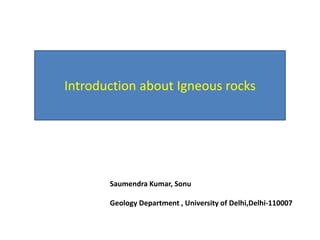
Igneous rocks intro lec 1
- 1. Saumendra Kumar, Sonu Geology Department , University of Delhi,Delhi-110007 Introduction about Igneous rocks
- 2. Igneous rocks The word igneous is derived from the Latin word ignus, meaning fire . The term igneous applies to natural process relating to the formation, movement, and cooling of molten materials—magma (hot, molten material underground), and lava. In geology, the word igneous applies to materials that have solidified from molten rock material, it also applies to the processes associated with the movement of molten material underground or erupting or the surface
- 3. When magma reaches the surface it becomes lava.
- 4. Heat convection from the mantle is the source of heat driving volcanic activity. This heat is remnant from its period of Earth's formation and the decay of radioactive elements
- 5. Igneous rocks are classified by their unique properties and characteristics which are related to composition of their host melt and the environmental setting where they form, underground or on the surface. Volcanoes form where molten material erupts on the surface. Regions where volcanoes occur, both modern (active or dormant) or ancient (extinct) have a unique variety of landforms. There are at least 500 active volcanoes around the world, of which about 25 are actively erupting, spewing out lava, rock, ash, and noxious gases.
- 6. Origin of igneous rock The Earth stores vast quantities of energy in the form of kinetic heat. Portions of the Earth's interior are molten, such as the outer liquid core. However, rocky materials in the overlying mantle are thought to be under too much pressure to melt. However, in many places, heat flow near the Earth's surface is high enough and confining pressure is low enough for rocks to melt. This molten material may find zones of weakness, such as along fault zones, to inject, melt, or under great pressure, find means to migrate to the surface. The Geothermal Gradient In most regions, the average temperature increases an average of 20 to 30 degrees C per kilometer with increasing depth in the upper crust. This temperature gradient (called the geothermal gradient) varies considerably with depth and location, depending on geologic settings.
- 7. What causes rocks to melt? Rocks will melt (generating magma) if heat flow increases in an area to the point that minerals reach their melting points. Other factors that cause melting include the introduction of hot volatile fluids (water and gases) into rocks under pressure, or if there is a decrease in pressure confining hot rocks (such as the release of pressure caused by a great earthquake). Melting ranges from only partial melting of select low-temperature minerals to complete melting under higher temperature conditions. As heat flow increases, more materials will potentially melt. “Igneous Rocks Are Rock Formed From Molten Material” Rocks formed from magma cooling and crystallizing underground are called intrusive igneous rocks. Intrusive igneous rocks form in naturally insulated settings (rock is a poor conductor of heat) so that minerals crystallize slowly, forming large, visible crystals. Rocks formed from cooling lava on or very near the surface are called extrusive igneous rocks. When lava cools rapidly it crystallizes quickly, preventing visible crystals from forming. Extrusive rocks include lava flows and pyroclastic materialsuch as volcanic ash, cinders, etc
- 9. How hot is magma/lava? The temperature of magma/lava plays perhaps the most important factor influencing igneous activity (both underground and on the surface). Temperature influences: • How minerals either melt or crystallize, • How much volatile content magma/lava can absorb, hold, and release. • How it influences the character of the volcanic eruptions. • the composition of rocks that can form when the material cools. • The texture of the rock that forms with the molten material solidifies • The kinds of volcanic landscape features eruptions can produce.
- 10. The table below illustrates the temperature of lava sampled from a variety of volcanoes around the world. Lava/Rock composition (place) Geologic setting Type of volcanic eruptions Temperature (C) sample (estimate range) Basalt hotspot - shield volcano, divergent zone - rift zone hot, fluid eruptions with extensive lava flows, rare explosive eruptions 1,170 Andesite convergent zone - arc - composite cone explosive eruptions and pyroclastic flows 1,075 Dacite convergent zone- arc - composite cone both explosive eruptions and lava flows, lava domes, pyroclastic flows (800 to 1,100) very large, catastrophic
- 11. General Characteristics of Intrusive and Extrusive Igneous Rocks The factors the help produce the texture and appearance of igneous rocks include: 1) the amount of dissolved gases in magma, 2) the rate at which magma cools, and 3) the amount of silica (SiO2) present. Intrusive igneous rocks form in naturally insulated settings (rock is a poor conductor of heat) so that minerals crystallize slowly, forming large, visible crystals. Extrusive igneous rocks that form from rapidly cooling magma (or lava) near or on the surface, crystallize quickly, preventing visible crystals from forming.
- 13. Economic Value of Igneous Rock Resources Most of the world's most precious metals, rare-earth elements, and gemstones come from rocks of igneous origin. Most gold, silver, copper deposits around the world are associated with igneous source rocks, or the sedimentary placer deposits derived from them. • Gemstones From Igneous Rock quartz as an example. • The Igneous Origin of Diamonds Kimberlite a special kind of intrusive igneous rock associated with some diatremes that sometimes contain diamonds. Kimberlites are typical coarse grained rocks with an bluish in color. Diamonds are xenoliths. • Building stone
- 14. References • Text book of geology- P.K. Mukhargee • Introduction of Igneous and Metamorphic petrology- winter • Myron G. Best. • Internet.
- 15. Thanks
